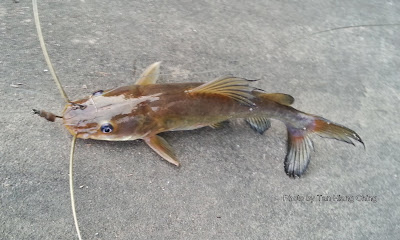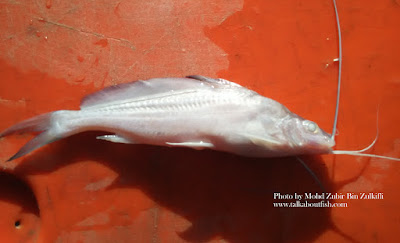Bagrid Catfishes
Bagrid catfishes belong to the Bagridae family. They are distributed in Asia and Africa. They have a spine before the dorsal fin, serrated pectoral spine, 6 to 7 soft dorsal rays and usually with 4 pairs of well developed barbels.
Bagrid catfishes are primarily freshwater fishes with some species that go into brackish water. Most of the species feed on small fishes, insects and plant detritus.
There are 20 genera and about 225 species worldwide. Malaysia has more than 20 species.
Bagrid catfishes are primarily freshwater fishes with some species that go into brackish water. Most of the species feed on small fishes, insects and plant detritus.
There are 20 genera and about 225 species worldwide. Malaysia has more than 20 species.
Scientific Name: Hemibagrus nemurus (Valenciennes, 1840)
English Name: Asian Redtail Catfish, Yellow Mystus, Green Catfish, River Catfish
Chinese Name | 鱼类中文名: 白须公 (Bái xū gōng)
Malay Name | Nama Melayu Malaysia: Ikan Baung, Sobong, Sopong
Bahasa Indonesia: Ikan Baung Tageh, Baung Putih, Tagih, Patik, Ririgi
Thai Name | ชื่อสามัญภาษาไทย: ปลากดขี้ลิง (Plā kd k̄hī̂ling), ปลากดเหลืองเล็ก (Plā kdh̄elụ̄xng lĕk)
Main Identification Features: Body colour brown often with greenish sheen. Fin gray with violet tint. Pectoral fin spines serrated along the inner edge. Base of adipose shorter than the base of dorsal fin base and about equal to the anal fin base. Four pairs of barbels.
Size: Maximum total length of 65 cm.
Habitat and Ecology: Inhabits wide range of habitats, including rivers and streams, lakes, marshlands, and freshwater swamps. Appear to prefers the lower stretches of rivers. Feeds on insects, larvae, crustaceans and small fishes.


Scientific Name: Mystus nigriceps (Valenciennes, 1840)
English Name: Twospot Catfish
Chinese Name | 鱼类中文名: 白须公 (Bái xū gōng)
Malay Name | Nama Melayu Malaysia: Ikan Baung Misai, Enge Enge
Bahasa Indonesia: Ikan Senggaringan, Lundu, Keting
Thai Name | ชื่อสามัญภาษาไทย: ปลากด (Plā kd), ปลาแขยงหางจุด (Plā k̄hæyng h̄āng cud), ปลาแขยงหมู (Plā k̄hæyng h̄mū)
Main Identification Features: Caudal fin deeply forked with upper lobe more or less produced and pointed but not filamentous. Dorsal spine is slightly serrated at the apex. The adipose fin immediately behind the dorsal fin is more than 3 times longer. Long nasal, mandibular, maxillary and mental barbels. Maxillary barbels reaching as far as the middle of caudal fin.
Size: Maximum standard length 20 cm.
Habitat and Ecology: Inhabits streams and rivers. Feeds on insect larvae and zooplankton.

English Name: Asian Redtail Catfish, Yellow Mystus, Green Catfish, River Catfish
Chinese Name | 鱼类中文名: 白须公 (Bái xū gōng)
Malay Name | Nama Melayu Malaysia: Ikan Baung, Sobong, Sopong
Bahasa Indonesia: Ikan Baung Tageh, Baung Putih, Tagih, Patik, Ririgi
Thai Name | ชื่อสามัญภาษาไทย: ปลากดขี้ลิง (Plā kd k̄hī̂ling), ปลากดเหลืองเล็ก (Plā kdh̄elụ̄xng lĕk)
Main Identification Features: Body colour brown often with greenish sheen. Fin gray with violet tint. Pectoral fin spines serrated along the inner edge. Base of adipose shorter than the base of dorsal fin base and about equal to the anal fin base. Four pairs of barbels.
Size: Maximum total length of 65 cm.
Habitat and Ecology: Inhabits wide range of habitats, including rivers and streams, lakes, marshlands, and freshwater swamps. Appear to prefers the lower stretches of rivers. Feeds on insects, larvae, crustaceans and small fishes.


Scientific Name: Mystus nigriceps (Valenciennes, 1840)
English Name: Twospot Catfish
Chinese Name | 鱼类中文名: 白须公 (Bái xū gōng)
Malay Name | Nama Melayu Malaysia: Ikan Baung Misai, Enge Enge
Bahasa Indonesia: Ikan Senggaringan, Lundu, Keting
Thai Name | ชื่อสามัญภาษาไทย: ปลากด (Plā kd), ปลาแขยงหางจุด (Plā k̄hæyng h̄āng cud), ปลาแขยงหมู (Plā k̄hæyng h̄mū)
Main Identification Features: Caudal fin deeply forked with upper lobe more or less produced and pointed but not filamentous. Dorsal spine is slightly serrated at the apex. The adipose fin immediately behind the dorsal fin is more than 3 times longer. Long nasal, mandibular, maxillary and mental barbels. Maxillary barbels reaching as far as the middle of caudal fin.
Size: Maximum standard length 20 cm.
Habitat and Ecology: Inhabits streams and rivers. Feeds on insect larvae and zooplankton.
